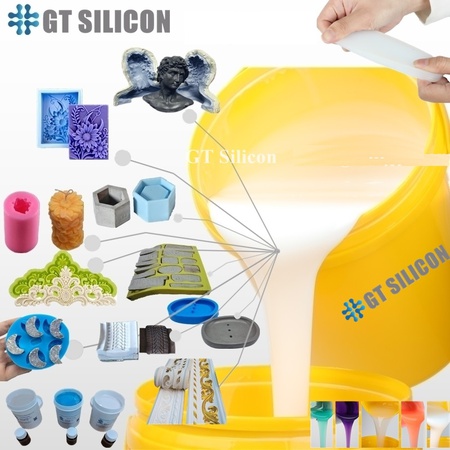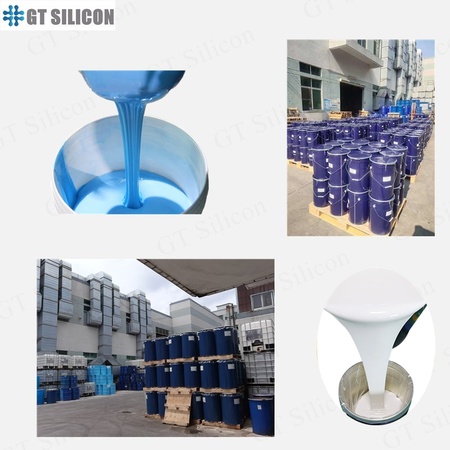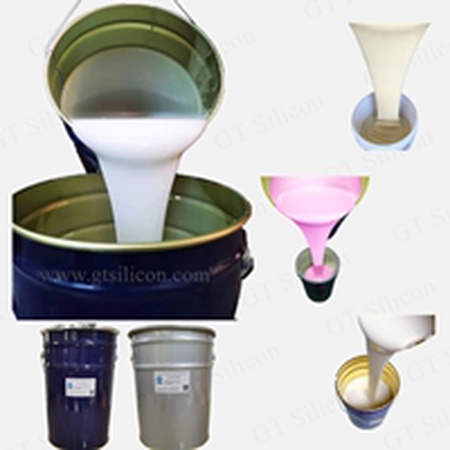


Product description
Product Description: Specification Condensate cured silicone rubber for mold making, also called condensate curing silicone rubber and tin curing silicone rubber, is a commonly industrial room temperature vulcanized liquid silicone rubber (RTV-2). Areas of use. Condensate cured silicone rubber has a wide application, such as mold making of gypsum, gypsum, concrete, cement, flower pots, candles, soap, resin products, cultural stone, sculpture, GRC/GRG restoration, etc. Technical parameters Model code GTSIL-T10 GTSIL -T15 GTSIL-T20 GTSIL-T25 GTSIL-T30 GTSIL-T40 Hardness Shore A 8-10 14-16 19-21 24-26 28-32 38-40 Viscosity - cP 10000-14000 12000 -16000 14000-18000 16000- 20000 26000-32000 10000-14000 Mixing ratio - % 3% 3% 3% 3% 3% 3% Tensile strength - kN/m2 10-15 15-18 19-23 23-27 25-30 16-20 Tensile strength - MPa 3.5-5.5 3.5-5.5 4-6 4-6 5-7 3.5-5.5 Shrinkage, % 0.30% 0, 30% 0.30% 0.30% 0.30% 0.30% Elongation % 400-500% 400-500% 400-500% 400-500% 350-500% 350-500% How to use 1. Preparation substrates The surface of the original must be clean and free of loose material. If necessary, especially on porous substrates, use a suitable release agent such as petroleum jelly or soapy water.2. Mixing Thoroughly mix Component A (silicone base) before use, as separation of the filler may occur during prolonged storage. Weigh 100 g of Component A (silicone base) and 3 g of Component B (hardener) in a clean container. Stir until the hardener is completely dissolved in the base. Manual or mechanical agitation may be used, but do not agitate for long periods of time and do not allow temperature to rise above 35°C (95°F). Mix suitable small amounts to ensure that component A (silicone base) and component B (curing agent) are thoroughly mixed. It is highly recommended to remove entrapped air in a vacuum chamber, allowing the mixture to fully expand and then collapse. After another 1-2 minutes under vacuum, the mixture should be checked and can be used if there are no air bubbles in it. Vacuum deaeration of the mixture results in an increase in volume by 3-5 times, so a sufficiently large container should be chosen. Note. In the absence of vacuum deaeration equipment, air entrainment can be minimized by mixing a small amount of component A (silicone base) and component B (hardener) and then applying a 1-2 mm layer to the original with a brush. Leave at room temperature until bubbles disappear from the surface and the layer starts to harden. Mix additional base and hardener and follow the steps below to make the final shape.3. Pouring the mixture and curing Pour the mixture of Par A (silicone base) and Part B (hardener) as soon as possible onto the original, avoiding air entrapment. The catalyzed material cures to a flexible rubber within 24 hours at room temperature (22-24°C/71.6-75.2°F), after which the mold can be separated from the original. If the operating temperature is much lower, the curing time will be longer. If the room temperature or humidity is very high, the run time of the catalyzed mixture will be shortened. The final mechanical properties of the mold are achieved within 7 days.
Learn more
Factory Price Good Quality RTV2 Moldmaking Tin Liquid Cured Silicone Rubber LSR Raw Materials Compound - 83313
Check availability
USD
4.5
-
6.5
USD
Minimum order: 200 kg
Supply ability: 500 kg/per month
Dongguan Gangtian Polymer Materials Co.,Ltd.
Not verified supplier
Dongguan, China
Shipping information
Calculate and complete your cargo transportation worldwide using Qoovee Logistics.
Guaranteed shipment on time and secure payment Calculate shipping from QooveeSimilar products
TCC Chemical Co, Ltd
Thailand
Specify the price
USD
0
0
Classification: AlcoholCAS No.: 64-17-5Other Names: Ethyl AlcoholMF: C2H6OEINECS No.: 200-578-6Place of Origin: ThailandGrade Standard: Food Grade, Industrial Grade, Medicine GradePurity: 99.9% min.Appearance: colorless transparent liquidApplication: ChemicalBrand Name: Fengda
TCC Chemical Co, Ltd
Thailand
Specify the price
USD
0
0
Classification: AlcoholCAS No.: 67-63-0Other Names: 2-Propanol; Isopropyl alcohol; IPAMF: (CH3)2CHOHEINECS No.: 200-661-7Place of Origin: Bangkok, ThailandGrade Standard: Food Grade, Industrial Grade, Medicine GradePurity: 99.9%, 99.95%min Isopropyl alcoholAppearance: Colorless Transparent LiquidApplication: Industry, cosmetics, and pharmaceutical,etcBrand Name: M&JMolar mass: 60.10 gmol1Density: 0.786 g/cm3 (20 °C)Boiling point: 82.6 °C (180.7 °F; 355.8 K)UN NO: 1219
TCC Chemical Co, Ltd
Thailand
Specify the price
USD
0
0
CAS No.: 141-78-6Other Names: acetic ether/EACMF: C4H8O2EINECS No.: 205-500-4Place of Origin: Bangkok, ThailandGrade Standard: Industrial Grade, Industrial GradePurity: 99.9%minAppearance: liquid, Colorless Transparent LiquidApplication: SolventBrand Name: XRModel Number: 99.9%minRelative Density: 0.9003Flash point: 4°CMolar mass: 88.11Boiling Point: 76.5-77.5 °C(lit.)Product name: Ethyl AcetateRefractive index(20°: 1.3723Dipole moment: 1.78Melting Point: -83.6°C
LLC "KoFa"
Russia
USD
8.0 - 10.5/pcs
DuPont™ Tyvek® 500 Hooded Jumpsuit Expert.Material: TYVEK polyethylene - 100%, 41 g/m²Weight: less than 180g.Closure: zipperDesign features: 3-piece hood provides optimal fit and freedom of movement of the head. Elasticated hood, cuffs and hem, glued-in elastic waistband.Design allows for freedom of movement.Easy to grip with gloves, oversized zipper pull tab.Tyvek® material is made from high-density polyethylene fibers using fast twist technology for a superior fit. protective properties, durability and convenience. Tyvek® is a breathable material that is permeable to air and water vapor, but repels splashes of aqueous solutions and aerosols. A high degree of barrier protection against fine particles, viral and bacterial agents, fibers up to 1 micron in size, and at the same time extremely low linting of the material itself. Antistatic treatment. Silicone-free. Applications: medical, pharmaceutical, chemical, oil and gas, equipment repair, paint spraying, general cleaning and many others. Complies with TR CU 019/2011Color: white Size range: S, M, L, XL, XXL, XXXL
LLC "KoFa"
Russia
USD
0.98/pcs
0.98
Reusable lint-free cloth for clean rooms, laboratories, operating rooms, industries with increased requirements for cleanliness. • Used to remove excess sealant, mastic and other contaminants. • Due to the special structure of the knit, they have excellent absorbent properties and are able to capture dust particles. • Wipes do not contain silicone. • Convenient size and unique strength properties provide multiple use - at least 50 applications. • Maintain hostile environment for processing - solvents, acids, alcohols. • Sterilization is possible. (Autoclave, chemistry) Particularly strong and durable - technical cloth with overlaid edges. The standard size of 35x40 cm is convenient for any manipulations when cleaning or wiping equipment. Package options: 3 pcs. 5 pieces. 10 pieces. and more FORMULA FOR CALCULATION OF THE BENEFITS OF APPLICATION AND PURCHASE: 90r / 50 applications = 1rub 80 kopecks for 1 application!!!
DONSIB Global group
Russia
Specify the price
USD
0
0
Our Turkish company exports coal of all possible grades from Russia. Large ship shipments. 3000-50000mt ships. Possibly FOB CIF LC. Anthracite. Coke. Coking coal. Thermal coal. For Cement Plant. Sugar factory. Steel Plant. Metallurgy. Power plants. We work directly with consumers. After LOI application.
KMG Supply Company
Kazakhstan
Specify the price
USD
0
0
KMG Supply Company offers high quality caustic soda manufactured in accordance with international standards. Our product is widely used in various industries such as paper, textile, soap and detergent. Packaging: - Bags: The product is packed in 25 kg bags for ease of transportation and storage. Delivery and availability of goods: - We deliver throughout Kazakhstan and the CIS countries using vehicles. - For orders over 50 tons, we offer delivery of large quantities in covered wagons to ensure the safety of the product during transportation. - At the warehouse in Pavlodar there is a constant supply of caustic soda in bags. - We offer pick-up services, as well as sales both retail and wholesale. Advantages of our caustic soda: - High purity and stability of the product. - Compliance with international quality standards. - Flexibility in meeting individual customer requirements.
Geography of supplies: KMG Supply Company supplies caustic soda throughout Kazakhstan and the CIS countries, offering convenient and prompt logistics solutions for our customers.
TOO "Novi Trade"
Kazakhstan
USD
280.9/Ton
280.9
Low sulfur oil Kazakhstan. Volume: 10,000 tons per month, annual contract. Price: 125,000 tenge +5$.
LLC "Logistic Auto"
Russia
USD
65.39 - 95.26/Ton
Logistic Auto LLC is a major supplier and exporter of milled peat. We invite you to conclude a contract for the supply of milled peat with the following characteristics: High separated peat in big bags with a volume of 5000 liters. Characteristics: pH aqueous 3.5-4.5% - acidic 5.5-6.5-neutralized. Humidity no more than 65% * separated peat, acidic 8 separated peat, neutralized.
Hisham Kassem
Egypt
USD
46.0/Ton
46.0
✔️20' Container FCL = (27.5 Ton)
✔️Weight: Fully Customizable
✔️We choose thick bags material to protect the salt from outer weather conditions.
✔️Customized Packaging Available
✔️Available Private Label
Hisham Kassem
Egypt
USD
17.0/Ton
17.0
✔️1 Jumbo: 1 MT = 1000 Kg
✔️1 Bulk Carrier = 3000 MT
✔️Full Customization Available
✔️Customized Packaging Available
✔️We choose thick bag material.
✔️Available Private Label
Hisham Kassem
Egypt
USD
76.0/Ton
76.0
✔️20' Container FCL = (27.5 Ton)
✔️Weight: Fully Customizable
✔️We choose thick bag material to protect the salt from outer weather conditions.
✔️Customized Packaging Available
✔️Available Private Label
Suppliers in this category
All suppliers in the category
Product:
Supplier:
Min. order:
Directory
Marketing department:
Marketing department:
Marketing department:
Information
Inform manager that you found the product on Qoovee
The contact details of the supplier is not available!
Send message




